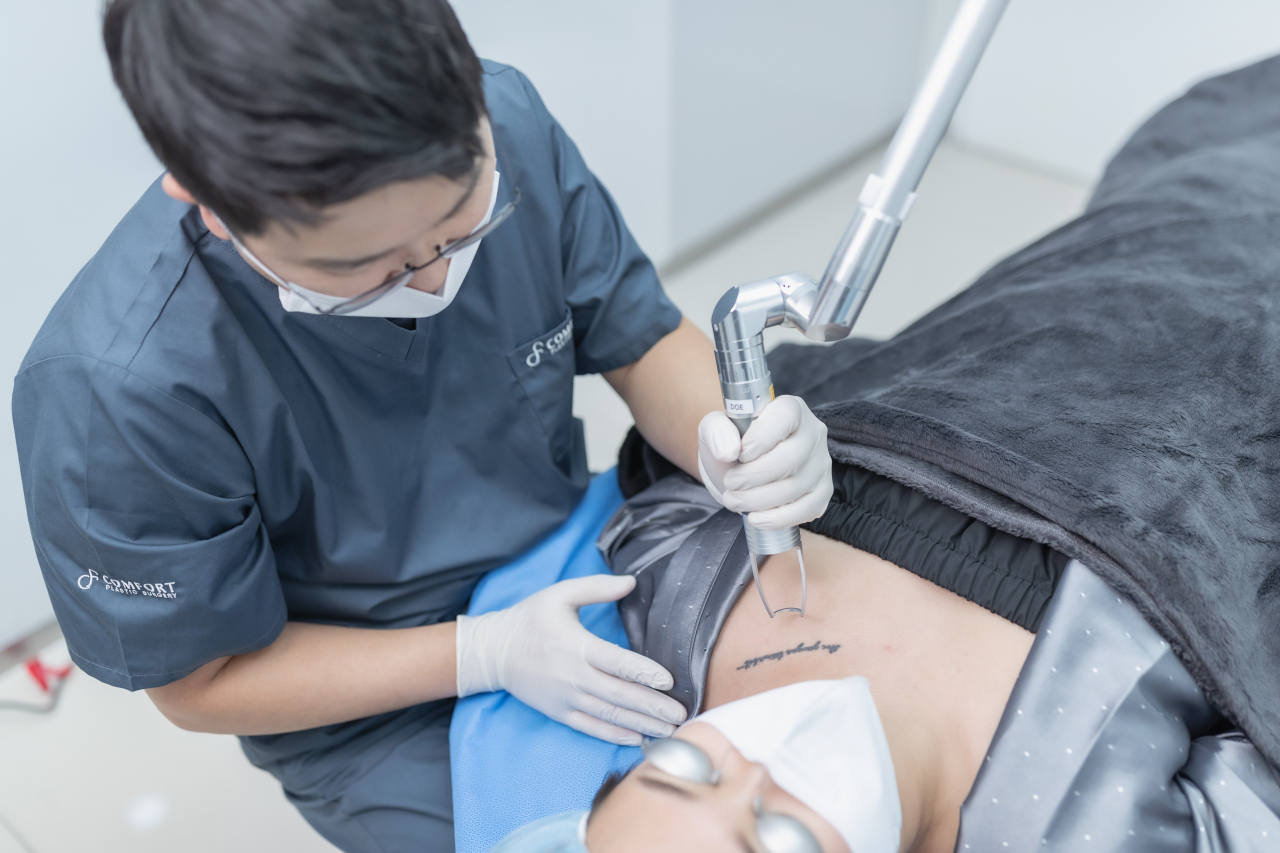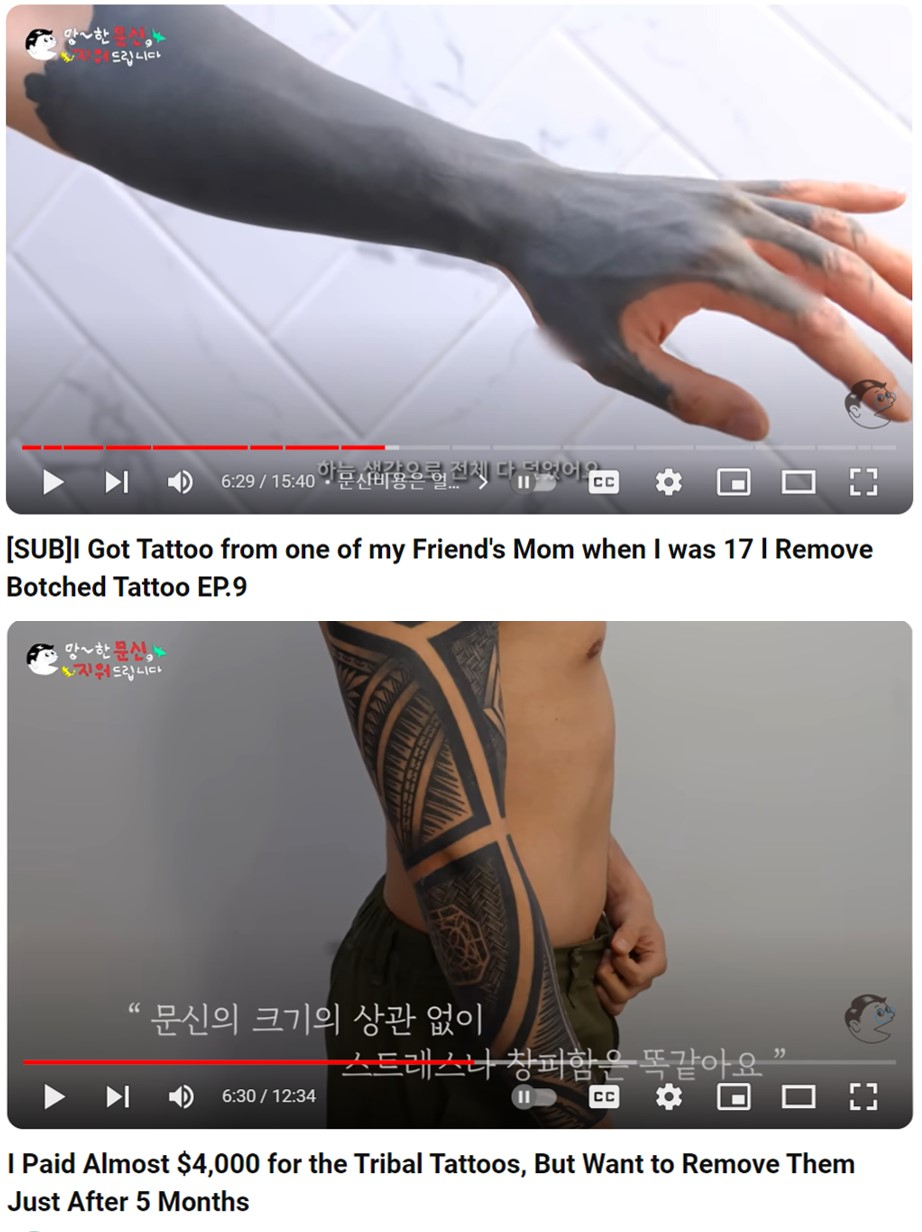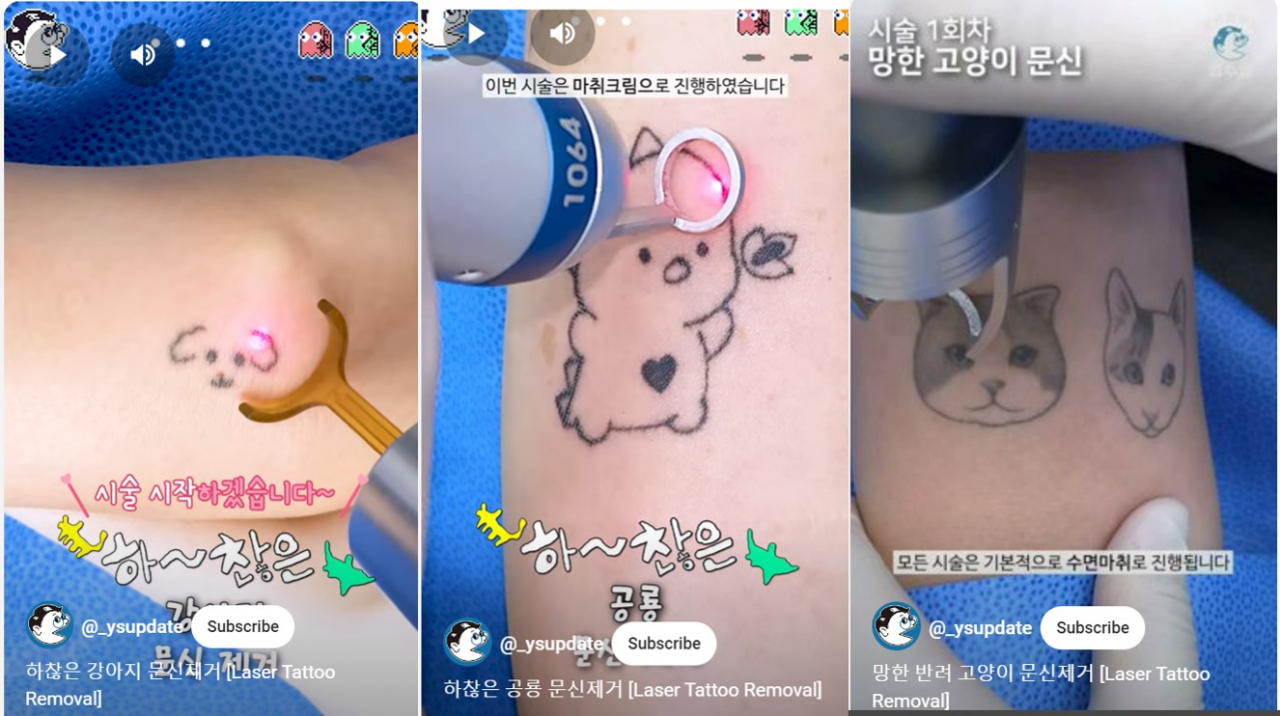 |
Dr. Park Young-soo performs a tattoo removal at his clinic. (Comfort Plastic Surgery) |
At a gathering of people with striking facial and body tattoos, a middle-aged man wearing fake tattoo sleeves attempts to blend in.
That’s Dr. Park Young-soo, filming for his popular YouTube channel at the Korea Tattoo Convention in Seoul, a major event for tattoo artists in South Korea. He’s there to learn about the latest trends and interact with people from the opposite side of his profession -- removing tattoos.
Every day, he meets people who regret their tattoos and seek removal. On his Korean-language YouTube channel, the doctor shares his patients' stories with their consent.
His message is simple: Think carefully before getting one.
“After all,” he said during an interview, “a tattoo creates a permanent scar.”
Undoing body art, stigma along with it
To be clear, he’s not advising against getting tattoos at all, but he knows intimately the disproportionate pain, time and cost involved in removing a tattoo compared to getting one.
Once you get a tattoo, removing it can be significantly more painful and expensive than the initial process. It can take over a year and complete removal is not always possible.
For instance, removing a tattoo the size of a business card costs approximately 220,000 won ($164) per session. Typically, around 10 sessions are required over two to three years, totaling about 2.2 million won. Even after all these sessions, the tattoo may not be completely erased, though it will have significantly faded.
Some patients believe that if they undergo enough removal treatments, their tattoos will be completely removed, but that’s not true, Park said.
"There is a limit to how much the ink can be removed. Once treatment reaches a certain point, it no longer brings change," he said.
"If a patient has tattoos with heavy ink and many colors, like Japanese 'irezumi' or old-school designs, and they want them entirely removed, I have to refuse," he added. "I can't meet their expectations."
Why do people want to remove them in the first place?
Although perceptions toward people with tattoos have been changing in the country, especially among younger generations, there is still a widespread prejudice in more conservative areas of society.
Some people find that older family members, workplaces and others still associate tattoos with rebellious behavior or gang affiliations. Due to that, many of his patients decide to undergo the removal process when applying for jobs or considering marriage.
One of his typical patient interview videos features a woman who, as a teenager, got a tattoo covering her left thigh. Now an adult, she struggles with the social stigma associated with such a prominent tattoo.
She says she feels uncomfortable wearing shorts in daily life. When she walks by, people openly stare, and she can feel their piercing gazes. Some even look at her as if they have seen something they should not have. In public bathhouses, older women click their tongues in disapproval.
Park also shared the story of a female patient who decided to get her design removed out of concern for her daughter, who was about to start kindergarten. Although she was proud of her tattoos, she didn't want her child to risk any chance of facing prejudice from mothers of other kids who might still hold negative views of those with tattoos.
Another patient studied abroad for many years and had a tattoo on the back of his neck. It was not an issue when he worked in the financial industry overseas, but when he returned to Korea's conservative financial industry, his Korean boss said made him appear unprofessional.
Before Park began removing tattoos, Park admits he himself held similar biases. But after meeting many of his clients, he realized his assumptions were not true.
"Most people I've met didn't lead the kind of lives I had imagined. They lived ordinary lives. Many could even be described as 'elites,'" he said.
Most people get tattoos for no big reason, he continued.
"It is not like they hung out with bad kids when they were young. They just did it because their friends did it or because it seemed cool."
 |
Screenshots from YouTube channel "Dr. Young-soo, Tattoo Removal Specialist" |
 |
Screenshots from YouTube channel "Dr. Young-soo, Tattoo Removal Specialist" |
Cut out for the job
How did a medical doctor become a specialist in tattoo removal?
Initially, he was an anesthesiologist. While doing three years of public health service as an alternative to active military duty, he started considering a second board certification. He wanted to be able to perform surgeries.
Uncertain whether his background as an anesthesiologist would be appreciated, he applied for a trainee position in plastic surgery and was granted an interview. However, a senior doctor at the hospital bluntly told him that he would not be able to handle the role due to his lack of surgical experience.
Park was taken aback, but applied to several more clinics. Eventually, one accepted him as a resident. He went on to become the only person in Korea certified for both plastic surgery and anesthesiology.
In 2018, he started working at a clinic where the treatments on offer included the removal of semipermanent makeup.
Observing how patients experienced significant pain during the removal process he realized there was a job perfectly cut out for him: removing tattoos while minimizing discomfort.
In 2022, he started his own clinic, called Comfort, near Gangnam Station in Seoul, starting his YouTube channel around the same time. Patients began flocking to his clinic from all over the country.
"When removing tattoos, doctors typically apply anesthetic cream, but its effectiveness in reducing pain is inconsistent. Some patients still experience significant pain," he said.
As a qualified anesthesiologist, he administers sedation and closely monitors the patient's condition, while performing laser treatment on the inked areas.
"Removing tattoos takes a short time, but the pain is immense," he said. "When using sedation, patients can sleep for five minutes and during that time, the removal procedure is completed in just one to two minutes."
The sedation he uses is a more involved process than the ones used for routine endoscopies here.
"For endoscopic sedation, it's sufficient to simply put the patient to sleep because the pain is minimal. However, tattoo removal is different. Even though the patients are asleep, they move violently because the pain is so intense," he said. "To prevent this, a doctor must control the pain effectively, which is only possible with an experienced anesthesiologist."
On topics like the potential harm of sedation or the risk of propofol addiction, an intravenous anesthetic used for sedation, Park speaks with the authority of an experienced anesthesiologist.
"When you undergo tattoo removal treatments, which typically require about 10 sessions, this process is spread over two to three years," he said. "This means you'll need sedation approximately three to five times per year. There is no medical evidence that this level of frequent sedation poses any risk to your health."
As for propofol, he said that it is not a drug that causes physical withdrawal symptoms. It only leads to psychological dependence.
With careful monitoring by a doctor, abuse of propofol can be prevented, he stressed.
Park typically sees 60 to 70 patients per day and finishes his work around 7 p.m. After work, he records all psychotropic drugs -- such as propofol -- used during the day.
You could be forgiven for thinking a tattoo removal specialist would be wary of deregulating the tattoo industry, but he says Korea's strict restrictions on tattooing are counterproductive.
Tattooing is currently considered a medical practice here, so only doctors are legally allowed to perform it. The lack of legislation to allow broader licensing makes the operations of nearly all of Korea's roughly 350,000 tattoo artists illegal.
Since the industry operates outside the boundaries of the law, tattooing is unregulated, Park said. He shared his encounters with patients who had tattoos in extreme and sensitive areas, such as the genitals, the roof of the mouth, the inside of the lips, the soles of their feet and armpits. Some minors also get tattoos.
"Rather than pushing tattooing into the shadows, the nation should legalize and institutionalize it to foster a safer and more respected culture," said Park.





![[Herald Interview] How Gopizza got big in India](http://res.heraldm.com/phpwas/restmb_idxmake.php?idx=644&simg=/content/image/2024/11/20/20241120050057_0.jpg)

